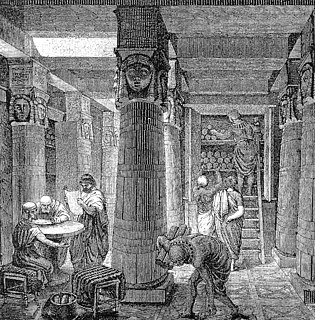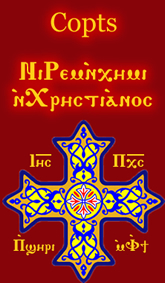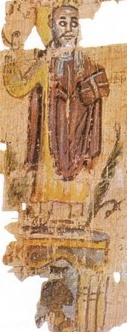
Cyril of Alexandria was the Patriarch of Alexandria from 412 to 444. He was enthroned when the city was at the height of its influence and power within the Roman Empire. Cyril wrote extensively and was a leading antagonist in the Christological controversies of the late-4th and 5th centuries. He was a central figure in the Council of Ephesus in 431, which led to the deposition of Nestorius as Patriarch of Constantinople. Cyril is counted among the Church Fathers and also as a Doctor of the Church, and his reputation within the Christian world has resulted in his titles Pillar of Faith and Seal of all the Fathers. The Roman emperor Theodosius II, however, condemned him for behaving like a "proud pharaoh", and the Nestorian bishops at their synod at the Council of Ephesus declared him a heretic, labelling him as a "monster, born and educated for the destruction of the church."

The Coptic Orthodox Church, also known as the Coptic Orthodox Patriarchate of Alexandria, is an Oriental Orthodox Christian church based in Egypt, servicing Africa and the Middle East. The head of the church and the See of Alexandria is the Pope of Alexandria on the Holy Apostolic See of Saint Mark, who also carries the title of Father of fathers, Shepherd of Shepherds, Ecumenical Judge and the thirteenth among the Apostles. The See of Alexandria is titular, and today the Coptic Pope presides from Saint Mark's Coptic Orthodox Cathedral in the Abbassia District in Cairo. The church follows the Coptic Rite for its liturgy, prayer and devotional patrimony. With approximately 25 million members worldwide, it is the country's largest Christian denomination.

The Great Library of Alexandria in Alexandria, Egypt, was one of the largest and most significant libraries of the ancient world. The Library was part of a larger research institution called the Mouseion, which was dedicated to the Muses, the nine goddesses of the arts. The idea of a universal library in Alexandria may have been proposed by Demetrius of Phalerum, an exiled Athenian statesman living in Alexandria, to Ptolemy I Soter, who may have established plans for the Library, but the Library itself was probably not built until the reign of his son Ptolemy II Philadelphus. The Library quickly acquired many papyrus scrolls, owing largely to the Ptolemaic kings' aggressive and well-funded policies for procuring texts. It is unknown precisely how many such scrolls were housed at any given time, but estimates range from 40,000 to 400,000 at its height.

The Metonic cycle or enneadecaeteris is a period of almost exactly 19 years after which the lunar phases recur at the same time of the year. The recurrence is not perfect, and by precise observation the Metonic cycle defined as 235 synodic months is just 2 hours, 4 minutes and 58 seconds longer than 19 tropical years. Meton of Athens, in the 5th century BC, judged the cycle to be a whole number of days, 6,940. Using these whole numbers facilitates the construction of a lunisolar calendar.
Hypatia was a neoplatonist philosopher, astronomer, and mathematician, who lived in Alexandria, Egypt, then part of the Eastern Roman Empire. She was a prominent thinker in Alexandria where she taught philosophy and astronomy. Although preceded by Pandrosion, another Alexandrine female mathematician, she is the first female mathematician whose life is reasonably well recorded. Hypatia was renowned in her own lifetime as a great teacher and a wise counselor. She wrote a commentary on Diophantus's thirteen-volume Arithmetica, which may survive in part, having been interpolated into Diophantus's original text, and another commentary on Apollonius of Perga's treatise on conic sections, which has not survived. Many modern scholars also believe that Hypatia may have edited the surviving text of Ptolemy's Almagest, based on the title of her father Theon's commentary on Book III of the Almagest.
Socrates of Constantinople, also known as Socrates Scholasticus, was a 5th-century Greek Christian church historian, a contemporary of Sozomen and Theodoret.

Dionysius Exiguus was a 6th-century Eastern Roman monk born in Scythia Minor. He was a member of a community of Scythian monks concentrated in Tomis, the major city of Scythia Minor. Dionysius is best known as the inventor of Anno Domini (AD) dating, which is used to number the years of both the Gregorian calendar and the (Christianised) Julian calendar. Almost all churches adopted his computus for the dates of Easter.

As a moveable feast, the date of Easter is determined in each year through a calculation known as computus. Easter is celebrated on the first Sunday after the Paschal full moon, which is the first full moon on or after 21 March. Determining this date in advance requires a correlation between the lunar months and the solar year, while also accounting for the month, date, and weekday of the Julian or Gregorian calendar. The complexity of the algorithm arises because of the desire to associate the date of Easter with the date of the Jewish feast of Passover which, Christians believe, is when Jesus was crucified.
The epact, used to be described by medieval computists as the age of a phase of the Moon in days on 22 March; in the newer Gregorian calendar, however, the epact is reckoned as the age of the ecclesiastical moon on 1 January. Its principal use is in determining the date of Easter by computistical methods. It varies from year to year, because of the difference between the solar year of 365–366 days and the lunar year of 354–355 days.
Annianus of Alexandria was a monk who flourished in Alexandria during the bishopric of Theophilus of Alexandria around the beginning of the 5th century. He criticized the world history of his contemporary monk Panodorus of Alexandria for relying too much on secular sources rather than biblical sources for his dates.
The Era of the Martyrs, also known as the Diocletian era, is a method of numbering years used by the Church of Alexandria beginning in the 4th century AD/CE and by the Coptic Orthodox Church of Alexandria from the 5th century to the present. Western Christians were aware of it but did not use it. It was named for the Roman Emperor Diocletian who instigated the last major persecution against Christians in the Empire. Diocletian began his reign on 20 November 284, during the Alexandrian year that began on 1 Thoth, the Egyptian New Year, or 29 August 284, so that date was used as the epoch: year one of the Diocletian era began on that date. This era was used to number the year in Easter tables produced by the Church of Alexandria.
Anatolius of Laodicea, also known as Anatolios of Alexandria, became Bishop of Laodicea on the Mediterranean coast of Roman Syria in AD 268. He was not only one of the foremost scholars of his day in the physical sciences as well as in Aristotelean philosophy but also a great computist.
Dionysius Exiguus's Easter table was constructed in the year 525 by Dionysius Exiguus for the years 532–626. He obtained it from an Easter table attributed to Patriarch Cyril of Alexandria for the years 437–531. The latter was constructed around the year 440 by means of extrapolation from an Alexandrian Easter table constructed around the year 390 by Patriarch Theophilus of Alexandria. The great historical importance of Dionysius' Easter table is twofold:
- From this Easter table Bede's Easter cycle would ultimately be developed by means of which all future Julian calendar dates of Easter Sunday were determined ;
- With his Easter table Dionysius introduced in passing the Christian era which would be developed into a full system for dating historical events by Bede two centuries later.
In the year 616 an anonymous scholar extended Dionysius Exiguus' Easter table to an Easter table covering the years 532 up to and including 721. Dionysius' table was published in 525 and only a century later accepted by the church of Rome, which from the third century up till then had given preference to go on using her own, relatively inadequate, Easter tables. From about the middle of the seventh century all controversy between Alexandria and Rome as to the correct date of Easter ceased, as both churches were now using identical tables.
Orestes was a Roman state official serving as governor of the diocese of Egypt in 415. During his term of office, he waged a violent feud against the bishop of Alexandria, Cyril, and their struggle precipitated the death of the philosopher and scientist Hypatia.

Coptic history is the part of the history of Egypt that begins with the introduction of Christianity in Egypt in the 1st century AD during the Roman period, and covers the history of the Copts to the present day. Many of the historic items related to Coptic Christianity are on display in many museums around the world and a large number is in the Coptic Museum in Coptic Cairo.
An ecclesiastical full moon is formally the 14th day of the ecclesiastical lunar month in an ecclesiastical lunar calendar. The ecclesiastical lunar calendar spans the year with lunar months of 30 and 29 days which are intended to approximate the observed phases of the Moon. Since a true synodic month has a length that can vary from about 29.27 to 29.83 days, the moment of astronomical opposition tends to be roughly 14.75 days after the previous conjunction of the Sun and Moon. The ecclesiastical full moons of the Gregorian lunar calendar tend to agree with the dates of astronomical opposition, referred to a day beginning at midnight at 0 degrees longitude, to within a day or so. However, the astronomical opposition happens at a single moment for the entire Earth: The hour and day at which the opposition is measured as having taken place will vary with longitude. In the ecclesiastical calendar, the 14th day of the lunar month, reckoned in local time, is considered the day of the full moon at each longitude.
This article lists people, events and other subjects which are referred to as "of Alexandria".

The Caesareum of Alexandria is an ancient temple in Alexandria, Egypt. It was conceived by Cleopatra VII of the Ptolemaic kingdom, the last pharaoh of Ancient Egypt, to honour her first known lover Julius Caesar. The edifice was finished by the Roman Emperor Augustus, after he defeated Mark Antony and Cleopatra in Egypt. He destroyed all traces of Antony in Alexandria, and apparently dedicated the temple to his own cult.

The Origenist Crises or Origenist Controversies are two major theological controversies in early Christianity involving the teachings of followers of the third-century Alexandrian theologian Origen.









